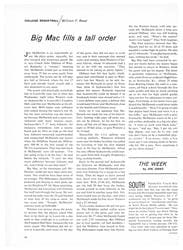
An armored force is on the march
To say that hordes of armadillos are creeping inexorably toward Connecticut may be putting the situation into stronger terms than is called for. However, thousands of the football-sized creatures have already crossed the Mississippi River, some possibly by walking on the bottom of it, and have wandered down into Florida and as far northeast as the Carolinas, with only their distaste for prolonged cold weather to keep them out of the gladiola beds of the Apawamis Country Club in Westchester County.
At the same time that armadillos are spreading out from their Southwestern habitat, they are also sweeping the country as an ambiguous symbol. Young people wearing armadillo T shirts may be seen from Tucson to Buffalo. There is an Armadillo Commune outside Atlanta, and a group identified as the Armadillo Rodeo travels the land in an old school bus. A stone sculptor in Comfort, Texas is whacking out a 600-pound statue of an armadillo for a rock music palace and community center called Armadillo World Headquarters in Austin, also the home of Armadillo Productions. Armadillo Press is across town, and there is an Armadillo Comics, an organization named the Armadillo Breeders Association, at least one Armadillo Racing Association, and Shiva's Headband has recorded Homesick Armadillo Blues in its new album, the jacket of which is a painting by Underground Artist Jim Franklin of armadillos in cosmic quantity.
Exactly why armadillos are taking hold as a youth symbol is a matter for speculation. Armadillos are paranoid little beasts who prefer to mind their own business. They love to sleep all day, then roam and eat all night. They are gentle, keep their noses in the grass and share their homes with others. Perhaps most significant, they are weird-looking, unfairly maligned and often picked on, and have developed a hard shell and a distinctive aroma. They do far more good than harm, and yet the usual social reaction toward an armadillo is to attempt to destroy it.
"We get lots of calls from people who are panicked because they've seen an armadillo in their yard," says Dennis Russell, a biologist with the Texas Parks and Wildlife Department. "They want to know what to do. I could say to shoot them, but that's too dangerous in the city. If I suggested poison, people would kill all the dogs and children in the neighborhood. Most people don't know how to use traps. So I just say to try to live with them."
The armadillo looks something like an armored aardvark. It has a long, sensitive snout and large, delicate, pebbled ears that have been compared to the grain of Morocco leather, and its body is encased in a bony structure like a classical Roman helmet. In different versions, the armadillo ranges throughout South and Central America and up through the heart of Mexico, or anywhere the climate is warm and there is water enough. About 100 years ago the armadillo population of the U.S. was restricted to southwestern Texas, where a giant armadillo ancestor called the Glyptodon prowled in prehistory when that area was a swamp. Since then, armadillos have steadily expanded their territory despite being constantly slaughtered by ranchers, souvenir salesmen, meat hunters and their most deadly unnatural enemy—the automobile.
Farmers and ranchers blame the armadillo for destroying crops and pocking the country with dangerous holes, although it may be argued that armadillos do away with more pests than crops and the holes they dig are good for aerating the soil. Armadillo shells once were popular as baskets and lampshades, a fad the animal has outlasted. For years people in South Texas have hunted the armadillo for its meat, considering it as good a sport as hunting quail. The meat tastes quite a bit like pork. During the Depression, the armadillo was called "the Hoover hog." In one Southwestern city there is a Tex-Mex restaurateur famed for his tamales. Wrapped in corn shucks, tons of them are served at catered parties. The tamales are stuffed with a mixture of beef, pork and armadillo meat. The meat is perfectly good, of course, although the tamale maker doesn't mention its source. He buys the armadillos from kids who capture them in the fields, paying up to a dollar for a 15-pound adult male.
One thing that works against armadillos is that they are fairly easy to catch and very easy to shoot. When not alarmed, the armadillo usually has its nose to the ground, sniffing for food, and sees only what is directly in front of its claws. It is not much of a coup to approach an armadillo from the rear and grab it by the tail, although the armadillo then will swing around in a sudden motion that wrenches itself free from inexperienced hands, meanwhile firing off an odor that tends to discourage pursuit. The next move for the armadillo is to dig or to run. "An armadillo can stand on its nose and disappear," says Paul Crume, Dallas Morning News columnist and member of the Armadillo Breeders Association. If running is the choice, the armadillo is amazingly quick. It likes to double back rapidly and plunge into the nearest thorn thicket, saved by its armor.
Armadillos enjoy water and have a rather interesting option when it comes to traveling across a pond or stream. With great gulps of air, the armadillo can pump up its stomach and intestines so that it floats like a rubber duck and then can paddle along indefinitely. Or the armadillo can simply walk into water, trudge across the bottom and emerge on the other side with its shell streaming and its ears twitching, a sight that has confounded fishermen from time to time.
Many people have made pets out of armadillos. The animals never learn to do tricks like dogs and do not become affectionate, being as single-minded as bankers and suspicious as actors. But they are quite willing to have their ears scratched while they dunk their tongues into a bucket of worms, which are then crushed by peglike molars. Taking an armadillo for a walk on a leash is tricky, since the armadillo is inclined to start digging or, if on a concrete sidewalk, head like a windup toy for the nearest wall or dark corner. Franklin, the artist, frequently has a pet armadillo scrabbling around his studio, but he releases it after a few weeks. "They start getting very depressed," he says.
Although they have the appearance of ageless creatures, armadillos live only four years or so. Females spend roughly half their lives pregnant, the gestation period lasting nine months, and nearly always give birth to four babies of the same sex with the same configuration of scales and identical numbers of hairs. It is common for armadillos to share their burrows with rabbits, skunks and snakes. They sometimes dine on small reptiles and lizards.
The armadillo likes to make his home under a berry bush and is more than willing to rid a place of all the spiders, beetles, worms, crickets, scorpions, ants and termites that can be located by an extremely sensitive nose. A grub six inches underground is not hidden from an armadillo. On hot nights it is not unusual to hear an armadillo grunting and huffing in the yard as he claws headfirst into a buried colony of termites.
Although most people in the United States have never seen an armadillo and consider them exotic creatures, the roads of the Southwest are strewn with their carcasses in the summer, when armadillos are roving in search of food and water. Upon being suddenly frightened by the passing of a car, the armadillo has a habit of leaping up—thus bashing itself to death against the undercarriage. Coyotes, dogs and wild pigs kill armadillos by flipping them over and ripping out their stomachs before the armadillos can curl into a ball. But once inside a hole, the armadillo inflates its armor, wedges itself into the earth and is all but impossible to pull loose.
The armadillo began being used as a symbol a few years ago when Texas Ranger, the student humor magazine at the University of Texas, ran a photo on its cover of an armadillo on a platter at Thanksgiving. Bill Helmer, a former editor of Texas Ranger who is now an editor at Playboy, says they had nothing special in mind. "We just thought it was funny," he says. Others agreed. Gilbert Shelton, an esteemed underground comic artist, drew armadillos for Texas Ranger, and Glenn Whitehead did a famous Ranger strip called "The Dance of the Armadillos," showing two of the creatures in graceful ballet capers. Somehow, that strip was remindful of the time a hurricane tore apart a summer home on Long Island. In the surf the next day the grand piano was found, with a stuffed armadillo perched on top.
Now if a hardy armadillo scout scorns the threat of winter—against which its shell affords little protection—and is seen trotting across a fairway in a Manhattan exurb, nosing along on the trail of an insect, there is no reason to be frightened. Not only is the armadillo likely to be of some benefit to the neighborhood, both conversationally and as a pest remover, the animal also has reached high station as another sort of symbol, for it has a certain kind of status apart from that conferred on it by youth. A Christmas catalogue of Neiman-Marcus has offered for sale a "registered" armadillo, delivered live with a ribbon around its neck, for $96.
FOUR ILLUSTRATIONS

